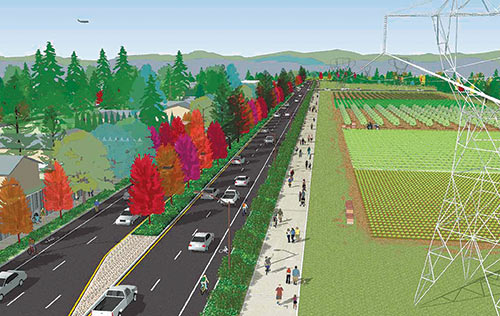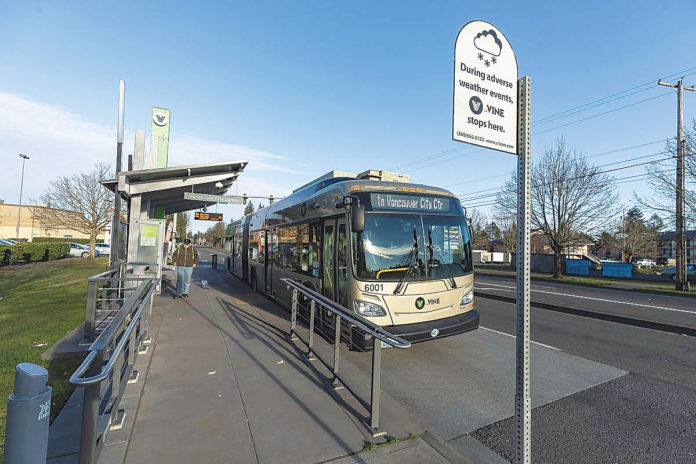The city of Vancouver is ramping up its transportation system plan update with the formation of a Transportation and Mobility Commission, seeking members now. The volunteer commission will provide advice to Vancouver City Council members, the city manager and city staff on a variety of transportation and mobility-related projects, programs and policies. It will also provide ongoing feedback and guidance on development of citywide transportation policy through the update of the city’s Transportation System Plan, which is now underway.
The city of Vancouver is looking for 11 volunteers representing various ages, affiliations and modes of transportation, in addition to a person with expertise or experience in freight movement and a person with expertise or experience in transportation planning, design, engineering, maintenance or operations. The first commission members will serve varying length terms, from one to three years. The commission will meet at least four times per year, but likely monthly. The deadline to apply is 5 p.m. March 17.
This is a brand new commission from the city, said Principal Transportation Planner Jennifer Campos.
“There is no committee or commission in place to look at transportation policy or implementation. It was set up in conjunction with the plan update,” she said, but it will be ongoing because Vancouver is seeing “increasingly complex transportation development projects and retrofit projects,” such as the Westside Bike Mobility Project and various projects that address the needs of the city’s increase in population and economic development.
The transportation system plan update began last fall, and is a 20-year update from the 2004 plan. The transportation system plan update is in its initial stages, said Campos, with data collection and data analysis the focus at this point. The city has contracted with Nelson/Nygaard, a national transportation planning consultant with an office in Portland. The organization describes its approach as “holistic” and focused on “broader community goals of mobility, equity, economic development and healthy living.” Nelson/Nygaard describes this stage of the two-and-a-half-year project as the “vision and discovery component” after which a “state of mobility” brochure will be released.
Similar to A Stronger Vancouver, the transportation system update process will have its own identity, including a name, brand and logo.

“Because it’s a pretty big undertaking with a lot of community conversation, we want to give it its own unique identity,” said Campos.
The update will be challenged to present the most effective ways to continue to accommodate residential and employment growth, and the new plan will have a separate component devoted to “how freight is going to move through the community,” said Campos. There is already a technical advisory committee in place to help develop the freight portion of the plan, and she said the city is going to “invite the business community to be actively involved in the project.”
“The business community’s role is going to be huge in the update of the plan,” she said.
There are several widening projects ongoing from the current plan. The widening of Southeast First Street is one of the city’s “biggest priorities,” said Campos. She projected the project will be out to construction within the next year and completed in the next couple years. The city is also continuing the improvement of the 136th/137th Street corridor, as well as connecting and widening 18th Street on both sides of I-205. Additional retrofit projects are not identified right now.
A significant portion of the plan will involve public transportation. A focus on transit in 2004 led to a high capacity transit study that wrapped up in 2008 and resulted in the implementation of bus rapid transit on the fourth plain corridor.
“It was a huge success for C-Tran, and now they are focusing on the Mill Plain corridor,” said Campos. “We think it’s been a great project for the community. The mayor is very proud of it because it was the first BRT implemented in the region. It serves a community out on Fourth Plain that needs service and access. We think the project was great, and we’re looking forward to Mill Plain.”
Simultaneous to the transportation system plan update, a renewed effort to replace the I-5 Bridge is coming into focus. Campos said the city acknowledges the potential impact of the bridge planning on Vancouver’s transportation system update, while still moving forward with a distinct citywide plan.
“We have to recognize with this plan in the Fourth Plain corridor is the potential of the bridge replacement plan, but it will not be a huge component of transportation system update,” she said. “It’s on its own trajectory.”
Innovation will play heavily into the city’s transportation plan update.
“It’s amazing to think back to the early 2000s,” said Campos. There was no social media, no iPhones, no AI available to the general consumer, no micro-mobility programs such as e-bikes and scooters and certainly no self-driving cars. “The concept of Uber and Lyft was not something anyone could imagine,” she said.
“It’s exciting this time around because of the technology,” she said. Data collection through Bluetooth and cell phone technology is likely to inform a huge component of the plan.
“It’s been about 20 years since we have updated the plan, and there have been so many changes in technology,” she said. “We need to keep more on top of that, and create a high level structure for us to move forward.”
Campos said this plan will better integrate individual components “into one modal plan that is consistent and integrated,” avoiding policy conflicts. “This is a deep dive into the city’s transportation system.”
Public outreach will begin in April and the project will be updated at www.beheardvancouver.org.




